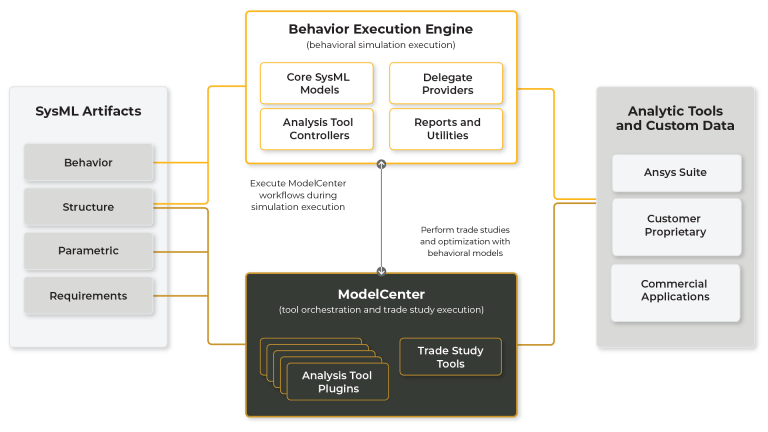Overview
This document provides a high-level overview of the different components that make up Ansys Behavior Execution Engine.

Figure 1: What does Behavior Execution Engine include?
The Execution Engine
The execution engine ingests, interprets, and instantiates your formal models and embeds them into a simulated physical environment, modeled by an analysis tool such as the Ansys Systems Tool Kit® (STK®) application. It uses patented AGI technology to coordinate time across all objects in the simulation as events take place. In other words, it does not use a discrete timestep to move the simulation forward, and instead it coordinates multiple clocks to ensure that all systems and sub-systems exist accurately and precisely in the same simulated universe. To learn more about how Behavior Execution Engine coordinates time, take a look at the introductory section of the Events help topic for SysML v1 or the Simulation Events help topic for SysML v2.
Analysis tool integration
Analysis tools such as the STK application, finite element tools, and proprietary system response software are excellent at modeling complex physics environments precisely. Behavior Execution Engine leverages these tools to model the time-dynamics of simulated systems. As Behavior Execution Engine coordinates events between state machines, it manages the exchange of data with your custom Java delegates, which in turn interact with your analysis tools. Delegates are the key component of Behavior Execution Engine's dependency injection architecture, enabling you to inject custom code to be executed in conjunction with time events, change events, and guards.
This integration of responsibilities and customizable execution enables you to focus on system design without the burden of modeling the physics environment. For example, you can simulate the interaction of systems modeled at different time scales, using different analysis methods, without requiring them all to participate in the same numerical integration. Furthermore, you can correlate these events to the associated analysis tools' output (reports, visualizations, etc.), highlighting key behaviors warranting further investigation.
Behavior Execution Engine also provides a way for you to integrate with the Ansys ModelCenter® application to execute workflows or trade studies that connect to analysis tools using the ModelCenter application's components instead of Java delegates. You can even use the Behavior Execution Engine component in the ModelCenter application to run a simulation as part of a workflow or trade study.
Moxie legacy
As you begin to use Behavior Execution Engine, you will quickly discover many references to Moxie. Behavior Execution Engine was formerly named Moxie and has retained the usage of the name Moxie in its SysML and Java elements in order to avoid major breakages.
Interoperation with No Magic Modeling Tools
Behavior Execution Engine, and previously Moxie, both had plugins into the Cameo (MagicDraw) SysML tools from No Magic. However, as of 2023 R2.1, we have removed those plugins to pursue a more product-independent and interoperable execution capability.
As our customers continue to implement model-based systems engineering solutions, we realize that every organization presents unique challenges in the way their engineers and designers work together and the tools they rely on. We recognize flexibility enables disparate software tools to share data and interoperate, and that is why our product strategy has focused on open APIs and interoperability.
In alignment with this product strategy, as of the 2023 R2 release, Behavior Execution Engine (BEE) has taken some necessary steps to rearchitect how it interacts with SysML modeling tools. In particular, we are moving to offer a more open and flexible way for our customers to leverage the behavior modeling capabilities. Now, BEE can execute independently, no longer requiring the use of a Cameo process. This enables you to author SysML using the Cameo authoring environment but to then reference those system architecture model project files directly from your own software platforms without needing Cameo to execute. This provides more collaboration options by loading the system model projects (e.g., the 'mdzip' file) directly, and it also unlocks scalability opportunities for customers needing to analyze larger design trade studies or even integrate directly into other engineering tools.
We know these are necessary steps in unlocking the full potential of behavior modeling across the growing portfolio of Ansys tools, and we look forward to bringing even more exciting new features to BEE users in our upcoming releases.
Thank you.
Ansys Product Management